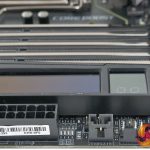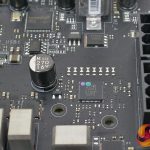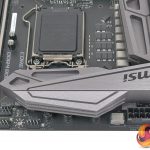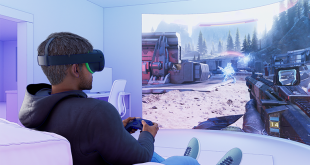On that last point it feels like we should include Game Boost in the Performance and Overclocking section of this review, however this feature is pretty much a gimmick that apparently highlights the way MSI has approached the design of the Godlike.
| Setting | Max Turbo | Vcore |
| 1 | 5.1GHz | 1.250V |
| 2 | 5.2GHz | 1.275V |
| 4 | 5.3GHz | 1.300V |
| 6 | 5.4GHz | 1.350V |
| 8 | 5.5GHz | 1.450V |
| 10 | 5.6GHz | 1.450V |
| 11 | 5.7GHz | 1.475V |
The Game Boost control has 11 positions that yield seven actual settings. As you click up each level the Maximum Turbo Boost speed is increased by 100MHz. On Auto settings a Core i9-9900K has a maximum Boost of 5.0GHz on two cores at 1.25V and we established in our review of the i9-9900K that overclocking is pretty much off limits. You can push all cores to 5.0GHz or perhaps 5.1GHz but once you hit 1.35V the thermals start to get unpleasant. MSI’s Game Boost has a maximum Turbo speed of 5.7GHz at a core voltage of 1.475V which is so far outside the bounds of possibility that it makes no sense.
In the unlikely event a Newb PC builder has spent £600 on this motherboard along with the best part of another £600 on a Core i9-9900K, they might think the Game Boost control gives them licence to dial in an overclock of more than 5.5GHz, in which case they are going to be disappointed.
On the other hand if an experienced overclocker buys the Z390 Godlike there is no chance whatsoever they will use Game Boost, but will instead dive inside the BIOS and get all manual on the settings. As you will see in our video we started our testing in a highly conflicted state of mind.
At one level the Godlike packs in some high end hardware that caters to the enthusiast gamer or power user who will likely appreciate the Dynamic Dashboard screen. They may also enjoy the extensive RGB support and the Mystic Light Infinity screen above the I/O panel.
Moving to the I/O panel we see a modest number of USB ports and a number of ports and connectors that are of marginal value. PS/2 is only of interest to extreme overclockers, the 6.35mm headphone jack looks a bit peculiar as it suggests you will use audiophile headphones, the dual Ethernet ports take up a fair amount of space and those micro buttons for clearing the BIOS and updating the BIOS would surely be better located somewhere on the board.
Those same enthusiasts may possibly be interested in the M.2 Xpander-Z card and Streaming Boost HDMI card however it seems more likely to us they would rather go without and see a cut in the price of the motherboard.
The layout of the board seems to have been influenced by stylists rather than engineers. The heat sinks on the VRMs are big and chunky when we want them to be finned and elegant and they are topped off with the largest I/O shroud we can remember seeing. Also, what’s with the 6-pin connector about the graphics slot? Who the heck will ever need that? This power connector might be a nod to the extreme overclocker but it feels out of place.
As for that fourth PCI Express graphics slot, the answer must surely be no. We understand the ‘missing’ PLX chip, as it would cost a small fortune, but without that chip it makes no sense to include all those PCI Express slots. In fact, while you’re about it MSI, you might also remove the third graphics slot and free up more space in the lower half of the board. There are times when less is more.
Be sure to check out our sponsors store EKWB here
 KitGuru KitGuru.net – Tech News | Hardware News | Hardware Reviews | IOS | Mobile | Gaming | Graphics Cards
KitGuru KitGuru.net – Tech News | Hardware News | Hardware Reviews | IOS | Mobile | Gaming | Graphics Cards










